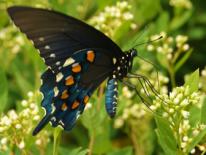
Gardening and landscaping with native plants can help improve both the District’s natural and built environment. Native plants are naturally adapted to the local climate, weather, and soil conditions. Once established, native plants do not need pesticides or fertilizers and require minimal watering, which reduces water consumption and stormwater run-off.
What are native plants?
A native plant is a plant species that occurs naturally in a particular region, state, ecosystem, or habitat without direct or indirect human actions. In the District, this generally means plant species that existed prior to European contact.
Why do we need native plants?
Native plants are the foundation of most food webs and provide vital habitat for wildlife, including critical pollinators like the Monarch butterfly. While the District is working to create and preserve native habitat for local wildlife, residents also play a valuable role. Native gardening and landscaping in your yard will add beauty to your home and improve the environment and ecosystems of the District.
What are invasive plants?
Non-native plants have the potential to become invasive and harm the environment. Invasive plants are non-native plants that cause economic harm, environmental harm, and/or harm human health. Non-native invasive plants lack natural predators and often have traits such as high seed production and aggressive growth. Invasive species out-compete native plants and negatively affect native wildlife, plant communities, and ecosystems.
Resources:

